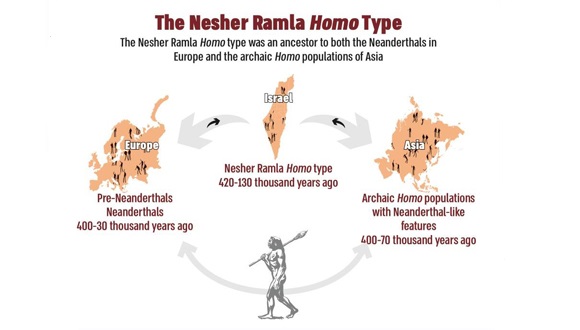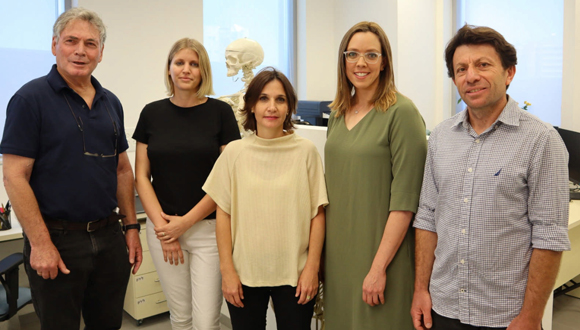TAU researchers unearth missing link in human evolution.
A new discovery by Tel Aviv University researchers may change the story of human evolution. The bones of an early human, unknown to science, were found at an excavation site near the city of Ramla. Researchers believe the remains represent one of the “last survivors” of an ancient human group that lived here at the Levant alongside Homo sapiens (modern humans) between 140,000 and 120,000 years ago.
Two teams of researchers took part in the dramatic discovery, published in the prestigious Science journal: an anthropology team from Tel Aviv University headed by Prof. Israel Hershkovitz, Dr. Hila May and Dr. Rachel Sarig from the Sackler Faculty of Medicine and the Dan David Center for Human Evolution and Biohistory Research and the Shmunis Family Anthropology Institute, situated in the Steinhardt Museum of Natural History at Tel Aviv University; and an archaeological team headed by Dr. Yossi Zaidner from the Institute of Archaeology at the Hebrew University of Jerusalem.
Until today, most researchers believed the small groups of Neanderthals arrived in the Levant from Europe about 70,000 years ago. The discovery of a new human group in this region, which resembles Pre-Neanderthal populations in Europe, challenges the prevailing hypothesis that Neanderthals originated from Europe, suggesting that at least some of the Neanderthals’ ancestors actually came from the Levant. In other words, TAU researchers are now suggesting instead that the famous Neanderthals of Western Europe are only the remnants of a much larger population that lived here in the Levant – and not the other way around.

Timeline: The Nesher Ramla Homo type was an ancestor of both the Neanderthals in Europe and the archaic Homo populations of Asia.
Another Piece to the Puzzle of Human Evolution
Prof. Israel Hershkovitz explains that the discovery of this new type of prehistoric human is of great scientific importance: “It enables us to make new sense of previously found human fossils, add another piece to the puzzle of human evolution, and understand the migrations of humans in the old world. Even though they lived so long ago, in the late middle Pleistocene (474,000-130,000 years ago), the Nesher Ramla people can tell us a fascinating tale, revealing a great deal about their descendants’ evolution and way of life.”
The important human fossil was found by Dr. Zaidner of the Hebrew University during salvage excavations at the Nesher Ramla prehistoric site, in the mining area of the Nesher cement plant (owned by Len Blavatnik) near the city of Ramla. Digging down about 8 meters, the excavators found large quantities of animal bones, including horses, fallow deer and aurochs, as well as stone tools and human bones. An international team led by the researchers from TAU and the Hebrew University of Jerusalem identified the morphology of the bones as belonging to a new type of earlier species, previously unknown to science. This is the first type of prehistoric human species to be defined in Israel, and according to common practice, it was named after the site where it was discovered – the Nesher Ramla Homo type.
WATCH: Researchers from TAU have identified a new type of early human at the Nesher Ramla site, dated to 140,000 to 120,000 years ago:
Neanderthals Made in the Middle East
“This is an extraordinary discovery,” notes Dr. Yossi Zaidner. “We had never imagined that alongside Homo sapiens, archaic Homo roamed the area so late in human history. The archaeological finds associated with human fossils show that Nesher Ramla Homo possessed advanced stone-tool production technologies and most likely interacted with the local Homo sapiens“. The culture, way of life, and behavior of the Nesher Ramla Homo are discussed in a companion paper also published in Science journal.
Furthermore, Prof. Hershkovitz explains that “Before these new findings, most researchers believed the Neanderthals to be a ‘European story’, in which small groups of Neanderthals were forced to migrate southwards to escape the spreading glaciers, with some arriving in the Land of Israel about 70,000 years ago. The Nesher Ramla fossils make us question this theory, suggesting that the ancestors of European Neanderthals lived in the Levant as early as 400,000 years ago, repeatedly migrating westward to Europe and eastward to Asia. In fact, our findings imply that the famous Neanderthals of Western Europe are only the remnants of a much larger population that lived here in the Levant – and not the other way around.”
Neanderthals and Sapiens Sharing Bed
Despite the absence of DNA in these fossils, the findings from Nesher Ramla offer a solution to a great mystery in the evolution of Homo: How did genes of Homo sapiens penetrate the Neanderthal population that presumably lived in Europe long before the arrival of Homo sapiens? Geneticists who studied the DNA of European Neanderthals have previously suggested the existence of a Neanderthal-like population which they called the ‘missing population’ or the ‘X population’ that had mated with Homo sapiens more than 200,000 years ago. In the anthropological paper now published in Science, the researchers suggest that the Nesher Ramla Homo type might represent this population, heretofore missing from the record of human fossils. Moreover, the researchers propose that the humans from Nesher Ramla are not the only ones of their kind discovered in the region, and that some human fossils found previously in Israel, which have baffled anthropologists for years – like the fossils from the Tabun cave (160,000 years ago), Zuttiyeh cave (250,000), and Qesem cave (400,000) – belong to the same new human group now called the Nesher Ramla Homo type.
“People think in paradigms,” says Dr. Rachel Sarig. “That’s why efforts have been made to ascribe these fossils to known human groups like Homo sapiens, Homo erectus, Homo heidelbergensis or the Neanderthals. But now we say: No. This is a group in itself, with distinct features and characteristics. At a later stage small groups of the Nesher Ramla Homo type migrated to Europe – where they evolved into the ‘classic’ Neanderthals that we are familiar with, and also to Asia, where they became archaic populations with Neanderthal-like features. As a crossroads between Africa, Europe and Asia, the Land of Israel served as a melting pot where different human populations mixed with one another, to later spread throughout the Old World. The discovery from the Nesher Ramla site writes a new and fascinating chapter in the story of humankind.”

The Nesher Ramla research team (left to right): Prof. Israel Hershkovitz, Marion Prevost, Dr. Hila May, Dr. Rachel Sarig and Dr. Yossi Zaidner.
Featured image: TAU’s Dr. Rachel Sarig, Dr. Hila May, and Prof. Israel Hershkovitz holding the Nesher Ramla fossils (photo: Tel Aviv University)
